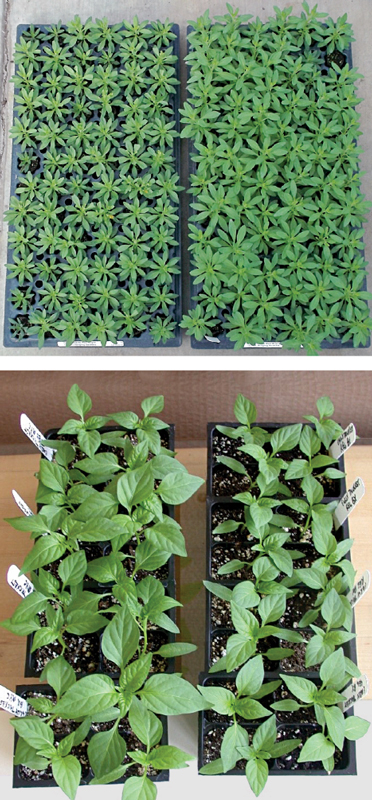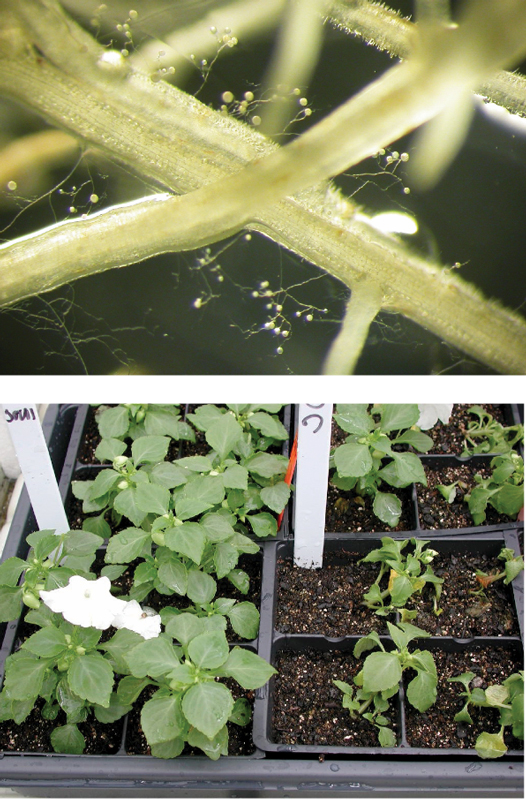11/1/2019
Getting the Best Out of Bios
Troy Buechel

Organic growing has a lot of challenges—from delivering readily available plant nutrients from complex organic fertilizers to crops, to finding safe materials to use to control diseases and insects. Beneficial biological organisms have been proven to be effective in helping with these challenges. If you’re considering using beneficial biological organisms, the information below should help provide the incentive needed to move toward their use.
Although there are many different types of beneficial biological organisms that can be used, this article will focus on those used in soilless growing media. Fortunately, most of the biological organisms available on the market are registered for use with organic growing. The two primary categories of beneficial biological organisms used in growing media are growth enhancers, such as mycorrhizal fungi and biofungicides that suppress root rot pathogens.

Mycorrhizal fungi
Mycorrhizal fungi are found in soils all over the world, and in the last 40 years of research, specific strains have been extracted and used successfully to inoculate soilless growing media. Mycorrhizal fungi are natural partners that help plants tolerate difficult growing conditions. They’ve evolved with plants forming a symbiotic relationship in which they efficiently mine out the soil or growing medium to deliver water and nutrients to the plant roots from areas where the plant roots aren’t present. In return, the plant provides mycorrhizal fungi with sugars to help them grow and survive.
In a conventional greenhouse growing system, most fertilizers are readily available for plant uptake, but mycorrhizal fungi can still assist by acquiring nutrients where plant roots aren’t found within the container. However, in organic greenhouse production, only a small percentage of an organic fertilizer is soluble, while most of the fertilizer elements are bound up within complex organic compounds. Mycorrhizal fungi help because they produce enzymes that help breakdown these complex, organic compounds, releasing beneficial plant nutrients and delivering them to plant roots.
Pictured top: Calibrachoa Cabaret Bright Red were untreated on the left and treated with Premier Tech Horticulture’s MYCORRHIZAE (Glomus intraradices ‘GHA180’) on the right. Notice in a conventional growing system that MYCORRHIZAE improved crop growth and the liners finished almost a week sooner. Photo: Premier Tech Horticulture.
Bottom: Bell peppers on the left were grown with Premier Tech’s MYCORRHIZAE (Glomus intraradices ‘PTB297’), while those on the right were not. Notice the growth difference due to the mycorrhizal fungi. Photo: Premier Tech Horticulture.
In addition to improving uptake of fertilizer elements and water, mycorrhizal fungi help reduce the effects of environment stress on plants, meaning that they’re less likely to succumb to stresses from over or under fertilization, excess soluble salts, insufficient watering, transplant shock, etc. Due to the improved overall health of many plants grown with mycorrhizae, plants often are larger with more flowers and fruit versus the same plants without mycorrhizal fungi. Benefits from mycorrhizal fungi are more noticeable when plants are under greater stress.
Not all mycorrhizae are the same
The most common types of mycorrhizal fungi used in crop production fall into two classes: endomycorrhizal fungi and ectomycorrhizal fungi. Endomycorrhizae colonize and benefit most greenhouse crops with the most common and beneficial genus used as an inoculant, called Glomus. Ectomycorrhizal fungi colonize many types of trees, but very few greenhouse crops. The most common genus of ectomycorrhizae used as inoculants include Rhizopogon, Pisolithus and Scleroderma. Although they’re good for colonizing certain tree and shrub species, they don’t colonize nor serve any benefit for greenhouse crops.
Biofungicides
Biofungicides are natural bacteria, fungi or actinomyces that have been extracted from soil and are used to inoculate soilless growing media. They’re a safer alternative to chemical fungicides and most are approved for organic growing. Each type of biofungicide—whether it’s a bacterium, actinomyces or fungi—has a different mode of action; however, they all feed from root exudates and colonize plant roots, which serve as a physical barrier that limits root rot pathogens from accessing the roots.
Bacterial and actinomyces biofungicides almost all produce antibiotics that serve as a natural fungicide that suppress specific root rot pathogens. On the other hand, fungal biocontrol species attack specific root rot pathogens by parasitizing them and consuming their internal fluids.
 Pictured top: The thick structures pictured are plant roots. The thin filaments near the roots are hyphae from endomycorrhizal fungi. At the ends of the hyphae are round structures called spores, which are the reproductive stage of endomycorrhizal fungi. Photo: Premier Tech Horticulture.
Pictured top: The thick structures pictured are plant roots. The thin filaments near the roots are hyphae from endomycorrhizal fungi. At the ends of the hyphae are round structures called spores, which are the reproductive stage of endomycorrhizal fungi. Photo: Premier Tech Horticulture.
Bottom: Impatiens inoculated with Rhizoctonia. Those in the left two packs were inoculated with BIOFUNGICIDE (Bacillus subtilis MBI600) and plant growth was normal as the BIOFUNGICIDE is suppressing the Rhizoctonia, while the two impatiens packs on the right without BIOFUNGICIDE are dying due to Rhizoctonia. Photo: Premier Tech Horticulture.
All commercial biofungicide organisms used in growing medium are effective at suppressing some, but not all, root rot pathogens. It’s best to check the label to verify the root rot pathogen(s) that are most problematic and suppressed by the biofungicide chosen. Having a biofungicide pre-incorporated into the growing medium provides insurance and peace of mind that if a root rot pathogen attempts to parasitize a crop that the biofungicide stands in the way, suppressing the pathogen. This reduces crop loss and saves headaches later trying to find an organic approved fungicide from a limited choice of products that will help control root rot pathogens in an organic growing system.
Compatibility of mycorrhizae and biofungicides
Since biofungicides suppress certain fungal root rot pathogens, they can also suppress endomycorrhizal fungi. If both are going to be incorporated into a growing medium, check with the manufacturer of the biofungicide to determine if their organism is compatible with endomycorrhizae.
Although buying growing media amended with an endomycorrhizal fungus and a biofungicide adds some upfront costs, consider the benefits of improved overall crop health. Healthier plants are not only less likely to exhibit nutritional deficiencies, succumb to environmental stress and be attacked by root rot pathogens, but are also less likely to fall victim to foliar fungal pathogens and insects.
In summary, all this translates into reduction of crop loss, improved crop performance, increased crop yields and overall increase in profits. Mycorrhizae and biofungicides are beneficial partners for successful organic crop production. GT
Troy Buechel is a Horticulture Specialist in Grower Services for Premier Tech Horticulture. He can be reached at buet@premiertech.com.